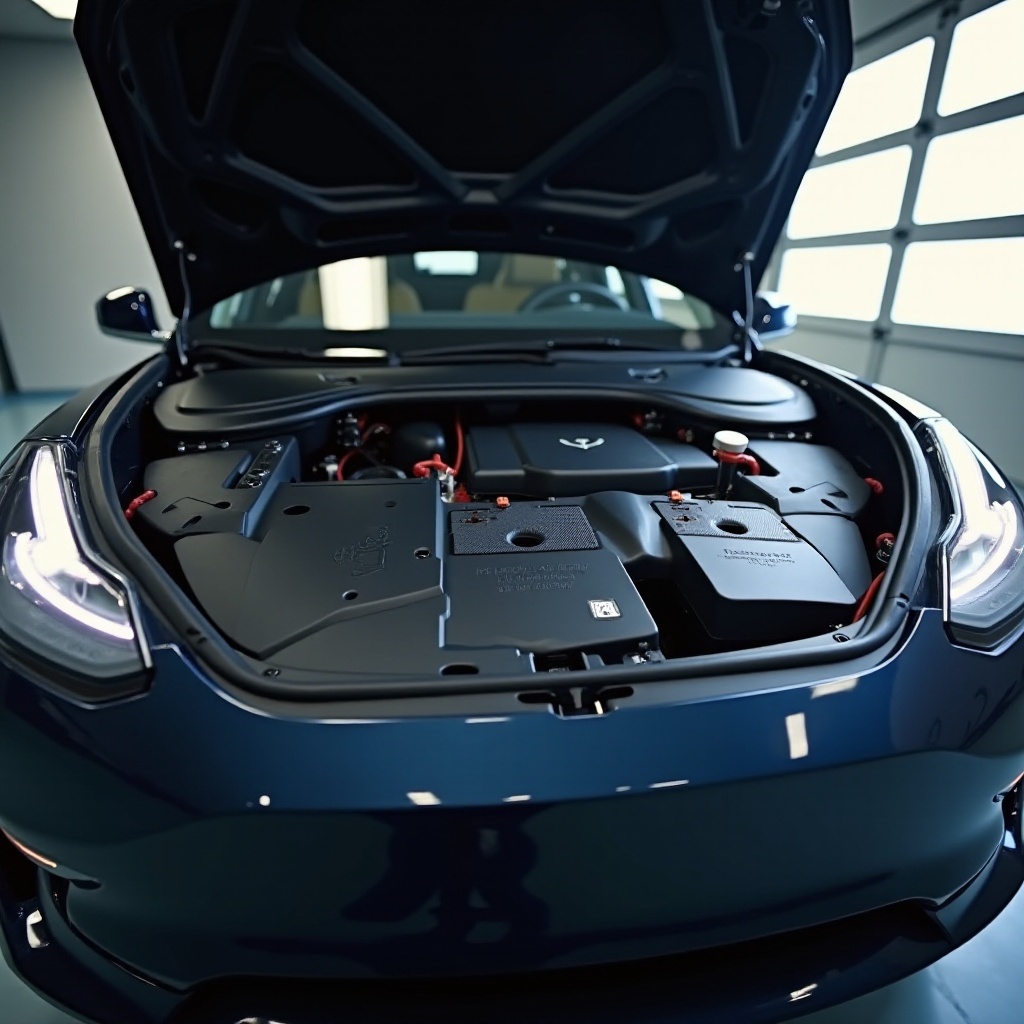Introduction
Battery degradation is a crucial factor for electric vehicle (EV) owners to understand, especially for those who own or plan to buy a Tesla Model Y. Ensuring the longevity and efficiency of your vehicle’s battery could save significant expenses and maintain optimal performance over time. This guide thoroughly examines Tesla Model Y battery degradation, including contributing elements, real-world case studies, and comparisons with other electric vehicles. Additionally, we will review Tesla’s strategies for mitigating battery wear, offering a holistic view of what to expect and how to maintain your vehicle efficiently.

What is Battery Degradation?
Battery degradation refers to the gradual loss of a battery’s storage capacity and performance over time. For EVs, it signifies a reduction in driving range and overall efficiency. This phenomenon results from the chemical and physical changes within the battery cells that occur during charge and discharge cycles. Understanding this process is vital for EV owners, as it directly affects the utility, reliability, and resale value of their automobiles.
Many EV manufacturers, including Tesla, provide estimations and charts showing expected battery degradation over time. These predictions are based on extensive testing and real-world data to give users a realistic expectation of battery performance throughout the vehicle’s lifespan. Grasping the concept of battery degradation enables users to make informed choices about charging habits and maintenance practices to prolong battery life.

Factors Influencing Battery Degradation
Several factors can influence battery degradation in the Tesla Model Y:
- Temperature: Extreme heat or cold can accelerate the wear and tear of battery cells, reducing their lifespan. Ideally, EV batteries operate at moderate temperatures.
- Charge Cycles: Each time a battery charges and discharges, it experiences a cycle. More cycles mean more wear. Hence, deep discharges followed by full charges can degrade the battery faster.
- Charging Speed: Fast charging generates more heat than normal charging, which can expedite degradation. Opting for regular charging when possible can mitigate this risk.
- Driving Habits: Aggressive driving, frequent acceleration, and maintaining high speeds consume more energy, causing quicker battery depletion and increased degradation.
- Software Updates: Tesla frequently updates vehicle software to improve battery management and efficiency, but variations in updates can affect battery life over the vehicle’s lifetime.
- State of Charge (SoC): Constantly keeping the battery at a very high or very low SoC can strain the battery. Ideally, maintaining charge levels between 20% and 80% maximizes battery longevity.
Understanding these factors allows Model Y owners to implement better maintenance and usage practices, significantly prolonging their battery’s life and efficiency.

Analyzing the Tesla Model Y Battery Degradation Chart
Tesla provides comprehensive degradation charts for their Model Y, illustrating the battery’s capacity retention over time. These charts serve as valuable tools for predicting long-term performance and planning maintenance schedules.
The Tesla Model Y Battery Degradation Chart typically shows that after about 100,000 miles, the vehicle’s battery retains approximately 90% of its original capacity. This implies around a 10% decrease in range, which is relatively modest and manageable. Such minimal degradation reflects the advanced battery technology and management systems Tesla employs.
Graphically, the degradation curve tends to be steep initially but flattens out over time. This pattern indicates that most of the capacity loss occurs in the early years of battery life. Beyond this initial period, the degradation rate slows significantly, showcasing the durability and robustness of Tesla’s battery packs.
Interpreting this chart helps Model Y owners set realistic expectations regarding their vehicle’s performance and range. It also underscores the importance of optimal maintenance and conservative charging habits to minimize the effects of degradation.
Real-world Case Studies
Taking a closer look at real-world case studies can offer practical insights into battery degradation experiences among Tesla Model Y owners:
-
John’s Model Y: After 50,000 miles and two years of ownership, John’s vehicle showed a minimal degradation of just 5%. By following Tesla’s recommendations, such as avoiding frequent use of Superchargers and regular battery maintenance, John managed to slow down the degradation process.
-
Sara’s Model Y: Sara, on the other hand, noticed an 8% capacity drop after 60,000 miles. Her lifestyle involves regular long drives at high speeds. Despite experiencing slightly higher degradation, she remains satisfied with the battery’s performance.
These case studies illustrate how driving patterns, charging habits, and environmental factors can lead to variations in battery degradation among Tesla Model Y users.
Comparing with Other New Energy Vehicles
Comparing the Tesla Model Y battery degradation with other electric vehicles (EVs) provides a broader perspective:
- Nissan Leaf: Studies indicate that the Nissan Leaf suffers more significant degradation, with users reporting an average capacity loss of around 20% after 100,000 miles. This is partly due to the air-cooled battery pack, unlike Tesla’s liquid-cooling system that offers better temperature control.
- Chevrolet Bolt: The Chevy Bolt shows a battery degradation rate similar to the Model Y, retaining around 90% of its capacity after 100,000 miles. This similarity arises from employing efficient thermal management systems.
- Audi e-tron: The Audi e-tron, a premium EV with a comparable range, maintains around 85-88% capacity after the same mileage. This slightly higher degradation can be attributed to its higher power output and larger battery pack.
These comparisons place Tesla Model Y in a favorable position, demonstrating its effective battery technology and thermal management systems that stand up well to rigorous usage and various environmental conditions.
Tesla’s Solutions to Battery Degradation
Tesla continually seeks to mitigate battery degradation through several innovative approaches:
- Software Updates: Tesla’s over-the-air software updates optimize battery performance and management, distributing wear evenly across the cells.
- Improved Battery Chemistry: Tesla invests in researching and developing battery chemistries that provide greater stability and longevity. Their new 4680 cells promise better energy density and slower degradation.
- Thermal Management Systems: Advanced liquid-cooling systems in Tesla vehicles maintain optimal battery temperatures, preventing damage from extreme conditions.
- Charging Recommendations: Tesla advises charging habits that prevent overuse of the battery, such as avoiding frequent rapid charging and not charging to 100% regularly.
These measures collectively help in significantly reducing the rate of battery degradation and ensuring the longevity and reliability of the Tesla Model Y battery.
Conclusion
Understanding and managing battery degradation is critical for optimizing the lifespan and efficiency of the Tesla Model Y. By recognizing the factors that contribute to degradation and implementing Tesla’s solutions, Model Y owners can maximize their vehicle’s performance and lifespan. Comparing with other EVs highlights Tesla’s superior battery technologies, making it a reliable option for long-term use. Real-world experiences substantiate the efficiency of Tesla’s strategies and offer practical insights for maintaining battery health. In essence, with proactive care and adherence to best practices, Model Y owners can enjoy lasting battery performance.
Frequently Asked Questions
How can I minimize battery degradation in my Tesla Model Y?
To minimize battery degradation, avoid frequent rapid charging, maintain charge levels between 20% and 80%, and avoid exposure to extreme temperatures. Regular software updates and optimal charging routines are also beneficial.
How reliable is the Tesla Model Y battery degradation chart?
The Tesla Model Y battery degradation chart is highly reliable, as it is based on extensive real-world data and rigorous testing. It provides a realistic picture of what owners can expect over the lifespan of their vehicle.
How does Tesla’s battery degradation compare to other brands?
Tesla generally shows lower battery degradation compared to other brands like Nissan Leaf and Audi e-tron, primarily due to its advanced thermal management system and continuous improvement in battery technology.


